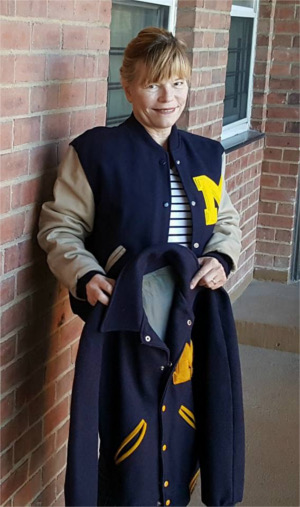
Patricia Kranz holds her old University of Michigan varsity letter jacket while wearing a new one that features proper school colors and design.
by Patricia Kranz
Early this year, I received a surprising letter. The athletic director of the University of Michigan was offering me a free varsity letter jacket. I already had a jacket in my closet that I had saved since winning it as a tennis player from 1973 to 1975, despite having moved from Michigan to Paris to Vermont to New York to Maryland to Russia and then back to New York. At the time, I did not realize that I was a member of the university’s first women’s varsity tennis team. I also did not realize that the jacket they gave me back then was not the same as the jackets the varsity mens’ teams were given. (Some journalist I was!) The new jacket has leather sleeves, not wool, and a bigger maize-colored “block M,” just like the men’s. Back in 1974, legendary Michigan football coach Bo Schembechler opposed giving the jackets to women, saying it would “minimize the value of the ‘M’ in the eyes of not only our players but the public who place such a high value on it.” The men’s basketball coach agreed. Not until 1991 did female athletes at Michigan get the same jacket as the men.
Warde Manuel, the current athletic director, decided to right this wrong and offer all women varsity athletes from 1973 to 1991 a block M jacket. And on Nov. 18 and 19, the university honored us with two days of activities, culminating with a ceremony at halftime of the football game with Indiana University. Over 300 of us, clad in our jackets, ran through the tunnel on to the field of “The Big House” to the applause of over 110,000 people.
The recognition was heart-warming, if a long time coming. I found that many of the other early women letter winners also did not know that they were on the first varsity teams. Females had been playing on informal “club” teams, and the university did not even notify us when the teams were granted varsity status, thanks in part to Title IX, a federal law that required schools to give equal treatment to women in educational programs. (In my Illinois high school, prior to Title IX, I was a co-founder of the first girls’ tennis and golf teams.)
Soon after returning from Michigan, I watched the Amazon series “Good Girls Revolt,” based on a book by Lynn Povitch about female researchers at Newsweek who filed a class action suit in 1970 to get equal pay and treatment with men. (Women could not be listed on the masthead as reporters or writers despite doing reporting and writing that helped their male colleagues!) I loved the series so much, I immediately bought and downloaded the book. Without giving a reason, Amazon recently declined to sign the series to a second season. Despite the progress that has been made in women’s rights in my lifetime, there is still a long road ahead for the next generation.



